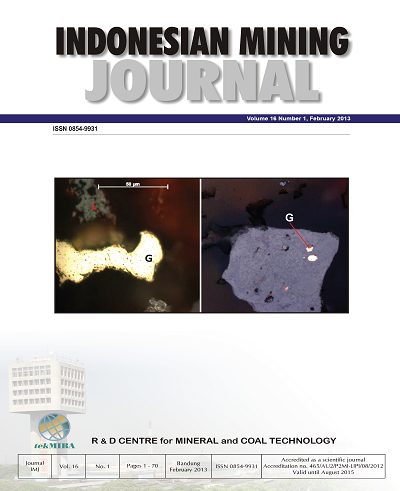STUDY ON ASHES OF BLENDED COAL-BIOMASS FOR CO-FIRING SYSTEM IN A COAL FIRED BOILER
DOI:
https://doi.org/10.30556/imj.Vol16.No1.2013.438Keywords:
coal, biomass, co-firing, ash fusion temperature, slagging and fouling indexAbstract
Biomass and coal blend combustion or co-firing is a promising combustion technology. However, significant development work is required before large-scale implementation can be realized. Issues related to successful implementation of coal biomass co-firing mainly for power generation should be identified. This paper presents the results of the study on blended coal-biomass characterisation, particularly the ash chemical composition and ash fusion temperature to predict the slagging and fouling propensity in a coal fired boiler. The coal used in this research has a calorific value of 5,067 cal/g and the ash fusion temperature of softening temperature in oxidation condition (softening temperature-ox) is 1,228ºC, while the biomass used was baggase, straw and rice husk with the calorific value of 4,144; 3,545; 3,301 cal/g and the softening temperature-ox of 1,303; 1,420 and >1,500ºC, respectively. Experimental results for some varieties of fuel blends indicate that the proportion of 95%-5% of coal and baggase has the highest softening temperature-ox of 1,225ºC. The blend of coal and straw resulted in the highest softening temperature-ox of 1,240ºC at 95%-5%, while the blend of coal and rice husk, the highest softening temperature-ox of 1,235ºC was reached at the proportion of coal and rice husk at 90%-10%. According to the slagging and fouling index, blended coal and straw shows the best performance compared to that of blended coal either with baggase or rice huskReferences
Adisoma, G.S., 2013. Low rank coal potential and clean technology development, the 4th Indonesia-Thailand Energy Forum, May 23-24 2013, Kuta, Bali., 19 p.
Aho, M. and Ferrer E, 2005. Importance of coal ash composition in protecting the boiler against chlorine deposition during combustion of chlorine-rich biomass, Fuel, 84, p. 201-212.
Barroso, J., Barreras F., Amaveda, H. and Lozano, A., 2003. On the optimization of boiler efficiency using bagasse as fuel, Fuel, 82, p. 1451-1463.
Belonio, A., Ocon, V. and Co, A., 2011. Small-scale rice husk gasifier plant for community street lighting, Brochure of Garbage-In Fuel-Out (GIFO) Project Suki Trading Corporation, Lapu-Lapu City, Cebu, Philippines.
Carroll, A. and Somerville, C., 2009. Cellulosic biofuels, Annual Review of Plant Biology 2009, Vol. 60, p. 165-182.
Evald, A., 2011. Biomass statistics: Straw, Danish Energy Agency, FORCE Technology, 5th Edition, October 2011, 7 p.
Mentz, K., Pinkerton, J., and Louch, J., 2005. Potential mercury and hydrochloric acid emissions from wood fuels. Forest Products Journal. 55 (2), p. 46-50.
Nicholls, D. and Zerbe, J., 2012. Co-firing biomass and coal for fossil fuel reduction and other benefits— Status of North American facilities in 2010, United States Department of Agriculture Forest Service Pacific Northwest Research Station General Tech- nical Report PNW-GTR-867.
Radke, B., 2012. Sugarcane bagasse ash waste, Inter- nal Report of Civil and Environmental Engineering, University of Nevada, Las Vegas UNICAMP, Brazil June 5, 2012, 16 p.
Sami, M., Annamalai, K., and Wooldridge, M., 2001. Cofiring of coal and biomass fuel, Progress in Energy and Combustion Science 27, p. 171–214.
Sandberg, J., 2007. Fouling in biomass fired boiler. Malardaren university press licentiate theses, no. 75, Department of Public Technology, Malardaren University, 54 p.
Sodikin, I., 2013. Pembakaran bersama tepung batubara dan serbuk gergaji menggunakan pembakar siklon sederhana untuk industri kecil menengah, Jurnal Teknologi Mineral dan Batubara, vol. 09, no. 02, Bandung, hal. 108-117.
Speight, J., 2005. Handbook of coal analysis, A John Wiley & Sons, Inc., Publication Copyright 2005 by John Wiley & Sons, Inc., Hoboken, New Jersey, p.1-222.
Stams, A.F., Livingstone WR., Gremers MFG., and Brem G., 2009. Review of model and tools for slagging and fouling prediction for biomas co combustion, Workshop on High cofiring percentages in new coal fired power plants, Hamburg, 18 p.
www.bisyplan.bioenarea.eu/ash_appendix.pdf, accessed on 27 August 2013, 9 p.
Yahaya, D.B. and Ibrahim, T.G. 2012. Development of rice husk briquettes for use as fuel, Research Journal in Engineering and Applied Sciences 1(2), p. 130-133.
Downloads
Issue
Section
License
Indonesian Mining Journal provides immediate open access to its content on the principle that making research freely available to the public to supports a greater global exchange of knowledge.

This work is licensed under a Creative Commons Attribution-NonCommercial 4.0 International License.













